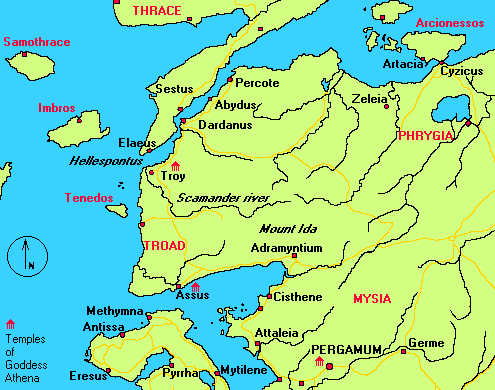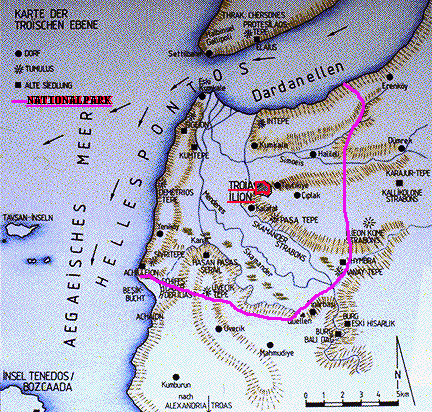| |
Troy and the Troad
Troy was founded by Tros and
was then called Illium, but the name was soon changed to Troy. Troy was located
on the peninsula of Troad. In the peninsula of Troad, there were many rivers.
The closest river to Troy was the Soamander River. There were also many cities
or small towns around Troy such as Colonae, Thymbra, Dardunus, and Arisbe. Troy
was in the region of Dardania which means "Trojan." There was one mountain in
the peninsula known as Mount Ida. Outside the peninsula were many seas. The sea
closest to Troy was called the Aegean Sea.

Troy (in northwest Turkey at the entrance of
the Dardanelles) is one of the oldest and most famous archaeological sites. It
had been thoroughly studied through two series of excavations - by Heinrich
Schliemann and Wilhelm Dörpfeld from 1871-91 and by Carl W. Blegen (University
of Cincinnati, Ohio) from 1932-38. The
settlement mound of Troy is situated in an excellent strategic position
between two continents and seas only a few kilometers from the Dardanelles
on a limestone plateau. This location, in conjunction with the special
conditions of the currents and winds, favored trade and cultural contacts.
It is thus possible to connect finds at Troy with other archaeological
sites. 3500 years of habitation on this site have left behind layers roughly
15 meters in height.

In 1988, after a hiatus of 50 years, the
excavations at Troy were once again resumed under the direction of Dr. Manfred
Korfmann from the University of Tübingen, with the cooperation of Dr. Brian Rose
from the Department of Classics at the University of Cincinnati. Every summer
since then a large international group, composed of archaeologists as well as
representatives of many other academic disciplines, has conducted excavations.
Because of its nearly continuous occupation for more than 3000 years, this site
is an important point of reference for the chronology of the ancient world from
the early Bronze Age through the Roman Empire.
When Heinrich Schliemann,
following upon the preparatory work done by the British landowner Frank
Calvert, started working in 1871 on the ruins on the hill, Hisarlik (Turkish:
inhabited hill/mound with fortress), he was convinced that the city of
Troy/Ilium from the legendary, bronze-age Trojan War, described by Homer
around 730 B.C.E., was to be sought here. Graeco-Roman antiquity had already
located the city on this spot - this is borne out by the expansion of the
city of Ilion as well as by the numerous tumuli which predominately served
hero cults. However, this knowledge was partially forgotten in the middle
ages and into the modern period.
In the Bronze Age, a shallow
bay stretched from the Dardanelles close to the foot of the fortress hill.
Today it reaches to the edge of the Scamander's drained estuary (present
Turkish name Karamenderes). The investigation of the topographical history
with the drilling of over 200 test holes, together with the inclusion of
the archaeological results, yields an idea of the area during prehistoric
times. A complete inventory of the Troad's archaeological sites is being
compiled with the aid of annual inspections. The inventory should serve
as the basis for their permanent protection. Thanks to continuous efforts
in conjunction with Turkish archaeologists and press for the preservation
of a cultural landscape worthy of protection the Troad was declared a historical
national park by the decision of the Turkish Council of Ministers in the
fall of 1996.
A further
international recognition of the continuous efforts in conservation of
the ruins of Troia was achieved in the year 1998: Troia was entered
into the UNESCO-List of World Heritage.
Since many years the general
public and the project team are demanding the erection of a museum at Troia
designed to house the many widely distributed finds at the place of origin.
This is a task in the responibility of the Turkish Republic.
Project Troia shall continue
in their demand.
Timeline of Troy
(Ilium)
An ancient city located in far northwestern Anatolia,
near the southern coast of the Hellespont. It is perhaps one of the best known
Bronze-Age city states, at least in terms of name recognition, from its role in
the Iliad, Homer's account of a war between Mycenaean Hellenes and the
Trojans. The actual history of the place is very poorly understood, although it
is known that as many as nine separate cities occupied the site between roughly
1600 BCE and about 400 CE, each being destroyed by natural disaster or warfare,
and each being built anew upon the remains of the previous. The community which
seems to be the one described by Homer is Troy VIIa, existing in perhaps the
13th century BCE.
-
Troy I (3000-2500 BCE) -
featured a
rubblework wall and mud-brick houses.
-
Troy II (2500-2200) -
The so-called "Burnt
City" with extended towered walls and royal treasure found by
Schliemann. The royal megaron was similar to those at Mycenae and Pylos.
Pottery wheels were found for production of distinctive flaring bowls and
goblets which can be found from Bulgaria to Syria. In addition, excavations
suggest major textile production
-
Original homeland of the Hittites..............c. 2300-c. 1900
-
Troy III (2200-2050) -
Dominated by stone
houses and ubiquitous evidence of deer as a primary source of food and other
goods. Troy III was sacked and burned in the 21st century BCE.
-
Troy IV (2050-1900) -
the rebuilt city was
dominated by a reconstructed citadel that covered four acres. The mud-brick
houses featured domed ovens. Cause of destruction is unknown.
-
To the Luvians.................................c.
1900-c. 1600
-
Troy V (1900-1800) -
Roomier houses with
corner seats and clay benches. Brighter colored pottery which is more
symmetrical, suggesting greater sophistication in production methods. The town
was again demolished, possibly by earthquake 1900-1800 BC
-
Troy VI (1800-1300)
Middle Bronze Age - Troy
during this period had an enormous citadel and shows signs of great wealth.
During this period horses were introduced, the area of the city was terraced,
making room for large stone houses on terraces. The city was destroyed by an
earthquake.
-
Troy VII (1300-1100) -
Late Bronze Age
Citadel. The city was far less grand than the one described by Homer, who
seems to have borrowed elements from Troy VI in his retelling. Many houses
were merely small cubicles along fortress wall which had been repaired from
Troy VI, albeit in smaller and less grand a scale. Jars set in floors suggests
rationing. The city plaza boasted a public well. Troy VIIa was sacked
and burned c. 1260 BCE but rebuilt c. 1190 by Thracians (Troy VIIb) who
produced knobbed pottery. VIIb was destroyed by fire at beginning of Iron Age
(possibly by the Sea Peoples
?)
-
??
-
DARDANID Dates are culled from traditional sources, and may be viewed
with indulgent scepticism.
-
Tros (also Lord of the Dardani)...................1423-1402
-
Ilos..............................................1402-1347
-
Ilos was the son of Tros and the brother of Assaracus,
who ruled Dardania.
-
Laomedon..........................................1347-1311
-
Priam.............................................1311-1270
-
Paris (Alexandros).................................mid 1200's ?
-
Hittite letters refer to a kingdom called Wilusa, which
some scholars believe is a Hittite version of Ilos, the legendary
ancestor-king of Troy. Here follows some data on that state...
Wilusa A kingdom referred to in Hittite sources as a member of the Assua,
a confederacy of minor states in northwest Anatolia allied with Hatti. Many
scholars now believe that "Wilusa" is the Hittite version of "Ilios", or
Troy.
-
Kikunni............................................fl. c. 1300
BCE
-
Piyamaradu (Priam ?)
-
Piyamaradu was a Hittite renegade who slew Kikunni and
seized the throne of Wilusa with the help of the Ahhiyawa, or Achaeans. He was
in turn overthrown by the Hittites who installed Alakshandu in his
place.
-
Alakshandu (Alexander, Paris ?)...................fl. c. 1280
-
A letter from the mid 1200s refers to "Alakshandu" as
king of Wilusa. Since another name for Paris, the prince of Troy in the Iliad,
was Alexandros, scholars have jumped on the possibility that the two documents
refer to the same individual.
-
Wilmu ?
-
?
-
Returning to the Troy archeological sequence...
-
Site abandoned, c. 1200-c. 700
-
To the Phrygians...............................c.
1200-c. 900
-
To the Aeolians.................................c.
900-546
-
Troy VIII (700-200 BC) -
The site is
reoccupied by Aeolian (Thessalian Greek) settlers and becomes a cultic center
- Both Xerxes and later Alexander the Great made sacrifices at its
shrines.
-
To Persia..........................................546-333
-
To Macedon.........................................333-323
-
To the Empire of Antigonus.........................323-301
-
Troy IX (300 BCE to 400 CE) -
Hellenistic
Ilion and Roman Ilium
-
To the Seleucid
Empire.............................301-263
-
To Pergamon........................................263-c. 210
-
To the Seleucid
Empire..........................c. 210-197
-
To Pergamon........................................197-133
-
To the Roman
Republic..............................133-27
-
To the Roman
Empire.............................27 BCE-395 CE
-
Site abandoned once again, c. 400, and never
rebuilt.
-
Within the Byzantine
Empire........................395-1204
-
Within the Latin
Empire...........................1204-1261
-
Within the Byzantine
Empire.......................1261-c. 1325
-
Within the Ottoman
Empire......................c. 1325-1922
-
Within the Republic of
Turkey.....................1922-
Trojans

-
TransAnatolie Tour
-
Multilingual Cultural Tour Provider and Operator
- A - Group
License N°4938 - The Turkish Ministry of Culture and Tourism
|
|